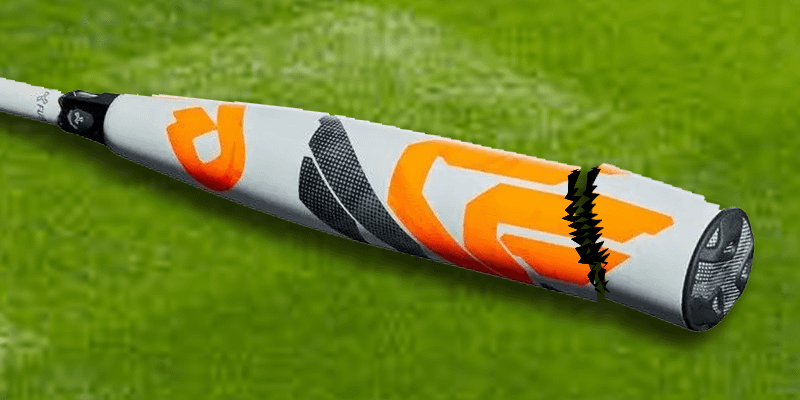Knowing if your composite baseball bat is cracked is crucial. Cracks can affect performance and safety.
Composite baseball bats are popular for their performance and durability. But even the best bats can crack with use. Identifying a crack early can save you from further damage. It can also prevent injury. So, how do you spot a crack?
It’s not always obvious. Sometimes, the signs are subtle. Understanding what to look for can help. In this post, we’ll guide you through the steps. You’ll learn how to check your bat properly. This way, you can keep playing safely and confidently.

Credit: betterbaseball.com
Signs Of A Cracked Composite Bat
Knowing the signs of a cracked composite baseball bat can help you avoid poor performance and potential injury. Identifying these signs early ensures you replace the bat before it causes problems. Here are the key indicators to look out for.
Visible Cracks
One of the most obvious signs is visible cracks on the bat’s surface. These cracks can appear as lines or fissures and may be small or large. Inspect your bat regularly for any signs of damage.
- Check the barrel and handle areas.
- Examine the connection points where the handle meets the barrel.
- Look for any unusual lines or splits.
If you see any cracks, it’s a clear sign your bat may be compromised. Using a cracked bat can affect your hitting performance and could be unsafe.
Unusual Sounds
A cracked composite bat often makes unusual sounds when it hits a ball. Pay attention to these sounds during play.
- A cracked bat may produce a dull thud instead of a sharp crack.
- You might hear a rattling noise inside the bat.
- Any change in sound is worth investigating.
These unusual sounds suggest internal damage. If you hear any, stop using the bat and inspect it thoroughly. A damaged bat can lead to poor performance and might break completely.
Inspecting The Barrel
Detecting a crack in a composite baseball bat is crucial. Start by inspecting the barrel. This part of the bat often shows the first signs of damage. Look closely and take your time. Your bat’s performance depends on it.
Surface Damage
Look for any visible surface damage. Scratches, dents, and small cracks are common signs. These can affect the bat’s performance. Run your fingers over the barrel. Feel for any rough patches or irregularities. Small cracks might be hard to see but can be felt.
Spider Webbing
Spider webbing is another sign of a cracked bat. These are small, hairline cracks that spread out like a web. They usually appear after a lot of use. Inspect the barrel under good light. Rotate the bat to see all angles. Spider webbing often starts near the sweet spot.
Assessing Performance Changes
Understanding how to tell if your composite baseball bat is cracked involves knowing the signs of performance changes. This guide breaks down the key indicators that your bat might have a problem.
Reduced Pop
A cracked bat often loses its “pop.” This means the ball doesn’t travel as far. You may notice a dull sound when hitting. This change suggests the bat’s structure is compromised. Pay attention to any reduction in hitting distance.
Vibration Issues
Another sign of a cracked bat is increased vibration. After hitting the ball, you might feel more sting in your hands. This discomfort indicates internal damage. A well-balanced bat should not cause such vibrations. These sensations point to a potential crack inside the bat.
Checking For Structural Integrity
Checking for the structural integrity of a composite baseball bat is crucial for performance and safety. Knowing how to identify a cracked bat can save you from potential injuries. It also ensures you play at your best. Two common methods to check for structural integrity are the flex test and barrel compression.
Flex Test
The flex test helps determine if your bat has internal damage. Hold the bat by the handle. Gently press the barrel against the ground. Apply moderate pressure. Watch the bat carefully. If it bends or flexes more than usual, it might be cracked. Listen for any unusual sounds. A cracking noise indicates a potential problem.
Barrel Compression
Barrel compression checks the bat’s outer shell for cracks. Press your thumbs against the barrel. Apply steady pressure. Rotate the bat and repeat the process. Feel for any soft spots or unusual dents. These signs can mean the bat is compromised. If the bat feels uneven, it likely has a crack.
Comparing To A New Bat
Determining if your composite baseball bat is cracked can be tricky. One effective way is to compare it to a new bat. A side-by-side comparison reveals several telltale signs of damage.
Weight Differences
An undamaged bat should feel consistent in weight. When comparing your old bat to a new one, hold both and note any differences. A cracked bat often feels lighter due to internal damage.
- Weight differences can indicate structural damage.
- A lighter feel suggests a loss of integrity.
Feel And Balance
Another way to detect cracks is to assess the bat’s feel and balance. A new bat has a solid, balanced feel. When swinging both bats, the cracked bat may feel uneven or off-balance.
- Check the bat’s overall feel when swinging.
- Notice any imbalance, which could signify a crack.
| Aspect | New Bat | Potentially Cracked Bat |
|---|---|---|
| Weight | Consistent | Lighter |
| Feel | Solid | Uneven |
| Balance | Well-balanced | Off-balance |
Regularly comparing your bat to a new one helps you spot issues early. This ensures your bat remains in top condition for optimal performance.

Credit: www.youtube.com
Evaluating Sound Variations
Evaluating the sound your composite baseball bat makes can help you detect cracks. A cracked bat often sounds different. This can be a key indicator. Let’s explore the sound variations you should listen for.
Dull Thud
A healthy bat produces a sharp, clear sound when it hits the ball. A cracked bat, however, often emits a dull thud. This sound lacks the usual “pop” you expect. To test, hit a ball off a tee or soft toss. If the bat sounds more like a “thud” than a “crack,” it may have a fracture.
Rattling Inside
Rattling inside the bat is another sign of damage. Hold the bat by the handle and shake it gently. Listen closely. If you hear a rattle or loose pieces moving inside, the bat may be cracked. This sound indicates internal breakage. This rattling often gets worse over time.
| Sound Indicator | Healthy Bat | Cracked Bat |
|---|---|---|
| Impact Sound | Sharp, Clear “Pop” | Dull Thud |
| Internal Noise | Silent | Rattling |
Consulting Manufacturer Guidelines
Consulting manufacturer guidelines helps you determine if your composite baseball bat is cracked. These guidelines contain important information. Knowing what the manufacturer says can save you time and stress. Follow their advice for the best results.
Warranty Information
Check the warranty information first. The warranty tells you what the manufacturer covers. Some warranties cover cracks. Others may not. Read the terms carefully. Knowing the warranty details can help you decide what to do next.
Authorized Inspections
Manufacturers often have authorized inspection centers. These centers know how to inspect your bat. They can tell if the bat is cracked. Find a list of authorized centers in the guidelines. Take your bat to an authorized center for a proper check.
Following these steps ensures you get the right help. Trusting the manufacturer’s advice can keep your bat in the game.
Seeking Expert Opinion
Sometimes, identifying a cracked composite baseball bat can be challenging. Seeking expert opinion can help ensure your bat is in good condition. Experts have the knowledge and experience to spot issues that you might miss.
Professional Coaches
Professional coaches have years of experience with baseball equipment. They can often tell if a bat is cracked by simply examining it. Coaches understand the performance of bats. They know how a damaged bat affects the game. Asking your coach to check your bat can save you from using a faulty bat.
Certified Bat Inspectors
Certified bat inspectors are trained to find damages in bats. They use special tools and methods to check for cracks. Inspectors can provide a detailed report on the condition of your bat. This can give you peace of mind. Knowing your bat is safe and fit for play is important.

Credit: www.youtube.com
Frequently Asked Questions
How Can You Spot A Cracked Composite Bat?
Look for visible cracks, fractures, or splits on the bat’s surface. Listen for unusual sounds when hitting.
What Are Common Signs Of A Cracked Bat?
Decreased performance, unusual vibrations, and visible damage indicate a cracked composite bat.
Can A Cracked Composite Bat Be Repaired?
No, cracked composite bats generally can’t be repaired. Replacement is usually necessary for safety and performance.
Do Temperature Changes Affect Composite Bats?
Yes, extreme temperatures can make composite bats more prone to cracking and damage.
Conclusion
A cracked composite baseball bat can affect your game performance. Check for visible cracks, unusual sounds, and changes in performance. Regular inspections help catch problems early. Replace cracked bats to stay safe. Keep your game at its best. Always handle your bat with care.
Enjoy your time on the field!

I’m Darrell Boyd, and I live and breathe baseball. As an ardent aficionado of the game, I have established myself as a respected figure in the baseball community through my dedicated blog and insightful contributions to the sport.
Through my blog, I strive to offer comprehensive baseball guides, tips, and tricks that cater to players of all skill levels. Additionally, I provide detailed reviews of crucial baseball products and elements, giving my readers an expert’s perspective on what truly matters in the world of baseball.
With a deep understanding of the sport’s technical intricacies and strategic nuances, I go beyond surface-level analysis, delving into the finer points that define successful gameplay. My meticulous attention to detail and unwavering commitment to excellence have made me a trusted resource for players, coaches, and fans looking to deepen their knowledge and appreciation of the game.
I am dedicated to fostering a thriving baseball culture and am passionate about sharing my wealth of insights with a growing community of fellow enthusiasts. My mission is to continue inspiring and educating others, leaving a lasting impact on the sport that resonates with millions across the globe.
